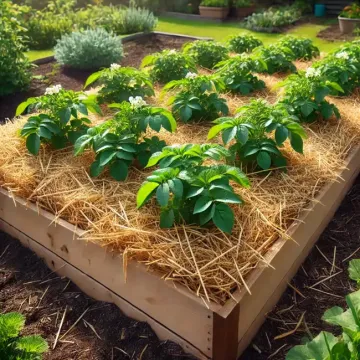Potatoes are a versatile, nutrient-rich crop that can be easily grown in a home garden. They are a staple food in many cultures, offering an array of culinary uses, from mashed and roasted to fried and baked. Home gardeners can enjoy the satisfaction of harvesting their own potatoes by following some simple guidelines to ensure a bountiful crop.
History of Potatoes
Potatoes (Solanum tuberosum) are native to the Andean region of South America, where they have been cultivated for over 7,000 years. The Spanish brought them to Europe in the 16th century, and they quickly spread across the continent due to their nutritional value and ability to grow in various climates. Today, potatoes are one of the world's most widely grown and consumed crops.
Types of Potatoes
There are several types of potatoes that can be grown in a home garden, each with its own characteristics:
- Russet Potatoes: Known for their brown, rough skin and fluffy texture when cooked, these potatoes are ideal for baking and mashing.
- Red Potatoes: With their smooth, thin red skin and creamy texture, red potatoes are excellent for roasting and boiling.
- Yukon Gold Potatoes: These potatoes have a yellow flesh and buttery flavor, making them versatile for a variety of cooking methods, including frying and mashing.
- Fingerling Potatoes: These small, elongated potatoes come in various colors and have a waxy texture, perfect for roasting or salads.
- New Potatoes: These are young, small potatoes harvested early in the season and are great for boiling or steaming.
Growing Conditions
Potatoes thrive in cool weather and well-drained, loose soil that is rich in organic matter. They prefer a slightly acidic soil with a pH of 5.0 to 6.5. Potatoes need full sun, at least six hours per day, for optimal growth.
- Planting Time: Potatoes are typically planted in early spring, as soon as the soil can be worked. The soil temperature should be around 45°F (7°C). In warmer climates, gardeners may also plant a fall crop.
- Seed Potatoes: Potatoes are grown from "seed potatoes," which are simply small potato tubers or pieces of tubers with at least one or two eyes (sprouts). It’s best to purchase certified disease-free seed potatoes from a reputable source.
- Planting Depth and Spacing: Plant seed potatoes about 4 inches deep and space them 12 inches apart, with rows spaced about 30 inches apart.
Growing Tips
- Hilling: As potato plants grow, gardeners should mound soil or mulch around the base of the plants to protect the tubers from sunlight, which can cause them to turn green and become bitter.
- Watering: Potatoes require consistent moisture, especially during the tuber formation stage. Water deeply and regularly, keeping the soil evenly moist but not waterlogged.
- Fertilizing: Potatoes benefit from a balanced fertilizer applied at planting and during the growing season. Too much nitrogen can result in lush foliage but fewer tubers, so opt for a fertilizer with a balanced NPK ratio or one with a slightly higher phosphorus content for root development.
Harvesting Potatoes
Potatoes can be harvested once the plants begin to die back. Early potatoes, known as "new potatoes," can be harvested when the plants are still green and the tubers are small, typically 10 weeks after planting. For larger, storage potatoes, wait until the plants have fully died back, usually about 80 to 100 days after planting. Use a garden fork to carefully lift the tubers from the soil, being cautious not to damage them.
Once harvested, allow the potatoes to cure in a cool, dark place for a few days to toughen the skins, which helps with storage.
Pests and Diseases
- Potato Beetles: These yellow and black striped beetles can quickly defoliate potato plants. Hand-picking beetles and larvae, as well as using organic insecticides like neem oil, can help control infestations.
- Blight: Potato plants are susceptible to both early and late blight, which can cause leaves to wither and rot the tubers. Crop rotation and resistant varieties can help prevent blight. If blight appears, remove affected plants to prevent the spread of the disease.
- Wireworms: These pests can burrow into potatoes, causing damage. Planting a cover crop before growing potatoes and rotating crops can help reduce wireworm populations.
Storing Potatoes
After harvesting and curing, potatoes should be stored in a cool, dark, and well-ventilated area, ideally at temperatures between 35°F and 40°F (1.6°C - 4.4°C). Avoid storing potatoes in the refrigerator, as this can convert their starches to sugars, affecting their flavor. Properly stored potatoes can last for several months.
Conclusion
Growing potatoes in the home garden is a rewarding experience that provides a plentiful harvest of a versatile and nutritious crop. By selecting the right variety, providing optimal growing conditions, and managing pests and diseases, gardeners can enjoy fresh, homegrown potatoes that will enhance their meals throughout the year.

